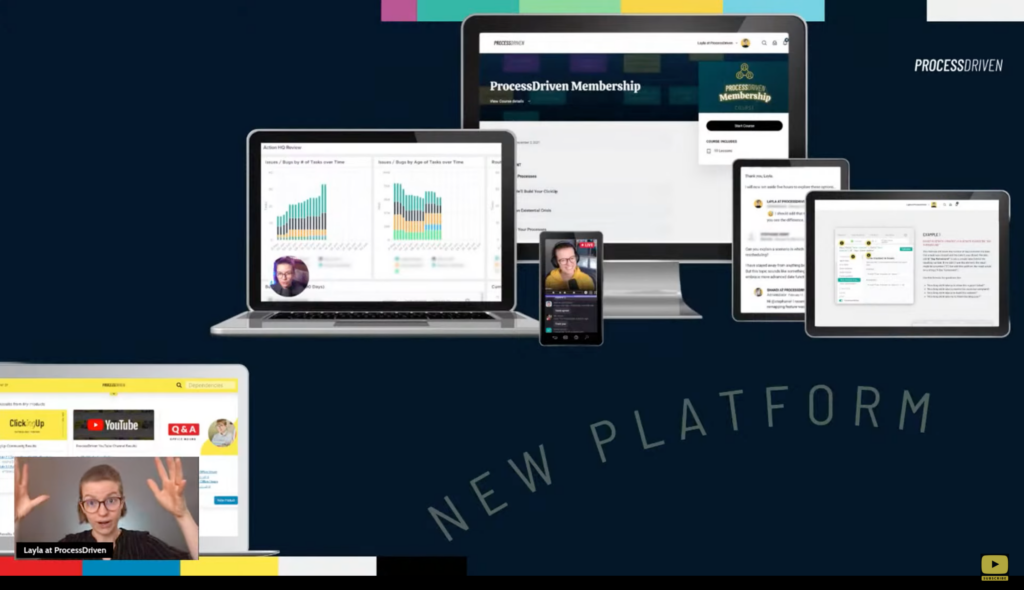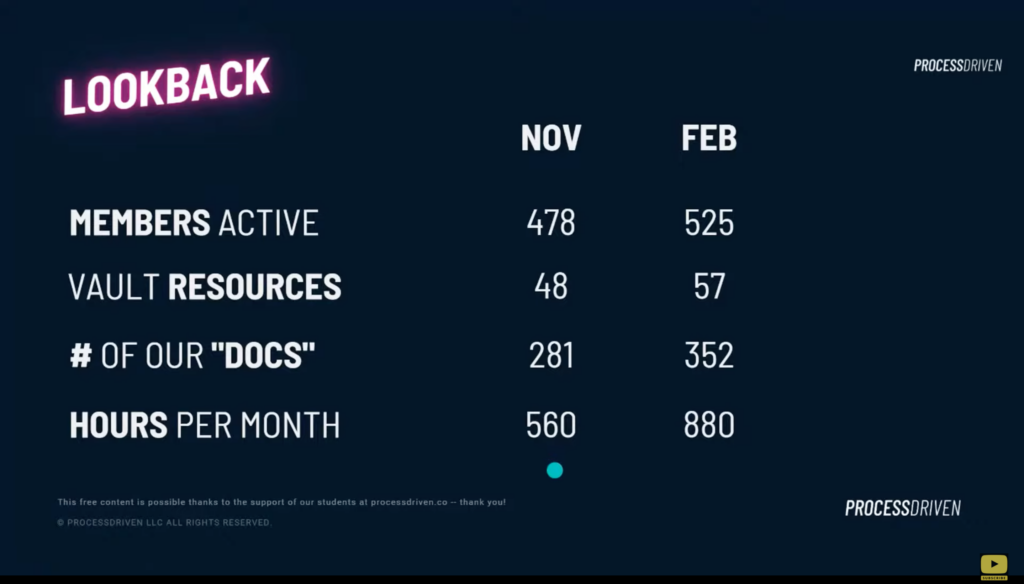Want a sneak peek into how we run our business at ProcessDriven? Layla’s Lookback is our video series dedicated to going behind the scenes into our membership, processes, and (of course) our ClickUp account! This episode will cover December 2021 to February 2022.
We’ll review the hiring process, updates to our new membership platform, cleaning up the books — and what’s in store for the future!
Key Topics To review
If you’ve seen some of Layla’s other Lookbacks, you’d know that this series is dedicated to reflecting on the business. We’ll focus on what happened and take an overall look at the past few months.
In this Lookback, we’ll review three main areas:
- Expectations
- Reality
- Looking Forward
Expectations vs. Reality
Let’s just say that some of our plans were a little optimistic.
The plan included 4 significant projects:
- Hiring & expanding 2 roles
- Solidify new platform & existing systems
- Internal Consulting initiative
- Books & Benefits clean-up
- Course update
These plans were ambitious, but let’s talk about what happened and the lessons learned from each attempt.
Project #1: Hiring & expanding 2 roles

What we thought would be a minor hiring reconfiguration turned into a massive change where almost every role in our business shifted somehow. Actually, I would say every role shifted in some way.
Not only did one full-time employee leave and one part-time employee increase to full-time (which we had planned on), we also had one subcontractor tell us that they wanted to leave in the new year, which is their right, to pursue other things. So, that was a curveball.
Not long after finding that out, we had a part-time employee (who’s been with ProcessDriven for a long time) tell us that they needed to pursue other things because their business was growing so much.
In all these situations, with every person who left, I was like, “I’m so happy for you! 🥳” but then, on the flip side, I was like, “Oh, my. 😰”
Suddenly, we went from having one team member leave and one team member shift to, well, a lot of things.
In addition to the planned hires, we added two subcontractors that we did not initially plan for. We also ended up increasing an additional part-time employee to full-time and having that person take over a few additional roles. Then, we added another part-time role. There was a lot of shift going on.
Today, the team looks very different from just a few months ago. We’ve got our core team of six. We’ve since had two wonderful team members leave us and move on to bigger and better things for themselves.
If you manage a team, you know things like this will happen — but, man, when it rains, it pours! It all seemed to occur at the same time.
With this whole hiring craze, part of the reason it became so crazy is that I hired too slow. I hired too slow because I didn’t have anybody else to execute the hiring process at the management level.
All of a sudden, when people gave notice, or things shifted, I had an increased workload and the burden of hiring, which is a dangerous position to be in.
As a result, I fast-tracked hiring the position I initially wanted to hire later in 2022 and hired our Operations Lead, who acts as an operations manager for the business. That decision was not easy because it’s a significant expense to add someone who’s solely going to be overhead.
I’m happy to say it’s been fantastic! I took things off my plate that took up about 20% of my time and made it someone’s 100%. The increase in quality, care, and oversight have been astounding, so I’m excited to see what’s in store for us!
Lessons Learned along the way
- Hire for skills and values, not Roles. Then, promote for interest, not skills.
- Departures aren’t personal; encourage people to do what’s right for them.
- Management is its own job. Ops people still need ops people.
- Hiring slow can cause more harm than good. Listen to your gut.
project #2: Solidify new platform & existing systems; Internal Consulting initiative

The next “perfect” plan we had going into this year was to launch a new site and stabilize it afterward. That was effectively the goal for December 2021.
In the last Lookback episode, when I mentioned this project, we had major things happening behind the scenes. We were debugging the brand new platform on the backend, and we were launching for our clients, which are online course students and membership members.
As part of this plan and as part of this project, the stabilization would involve a lot of internal training. So I wanted to spend more time in the next quarter helping my team build their processes out a little bit better.
I said when it rains, it pours, right? Anyone in the membership knows what happened here because we talked about it as soon as it happened. But for the rest of you, here’s what actually happened.
When we went to do this launch, one mistake, one typo changed the entire trajectory of the quarter. We talk about breaking a process until it’s perfect, right? Keep breaking it, and it’ll get better each time.
Well, sometimes there are times where you break a process, and it hurts. That’s precisely what happened to us in November 2021. Just a few days after the last Lookback, we had a team member editing some emails announcing the new website launch. Because of one typo, one number in the wrong spot, that email went out to our entire membership list a week and a half early.
Why does that matter? Well, a week and a half early in a website launch mean certain accounts might not be set up properly, certain features might not have been bug tested — all sorts of things needed to be done in that last week to make sure everything was ready to be released into production.
One typo blew that all out of the water. ProcessDriven had a Mayday situation on its hands.
At approximately 11:00 PM, I was CC’d on an email that went out to all existing members saying, “Hey, the new membership platform has launched!” and I looked at it, and I said, “Wait, what?”
Almost midnight, we had to decide whether we would send out an email saying, “Hold off, we’ll relaunch it in a week or two” or press on. It was a tough decision, but we decided to press on.
Working through the night, we got the website back up and running and mitigated the bugs before they hit on the East Coast morning time zone. It was terrible. It was an extreme example of what breaking the process feels like.
In this case, the process that broke was the checks and balances in scheduling an email. That’s it.
One tiny little thing that isn’t even an option built into your email marketing tools: the double-checking of an email date prior to it being scheduled.
This has since changed, but man, can breaking a process hurt? That was such a journey.
Given that we’ve accelerated ten days of work into one night, the workload became insane. The worst part about this whole situation was that the person who led this project was the same person who was planning on leaving in about four weeks after this happened.
This is the most challenging quarter I’ve had as a business owner since. I recognize that maybe many of you have all sorts of plans to prevent basic typos, but we didn’t have a great way to prevent this. We didn’t get an alert. Our email marketing tool didn’t tell us anything, no confirmation, nothing. It just got scheduled.
So that was a learning process. I don’t know if any of you have ever had something similar happen, but it is a journey.
Beyond that, we realized the importance of some more training.
The hiring project was now in full effect at this point, and we were also launching this new platform, which meant a lot of our procedures needed to be changed and modified.
We implemented two programs around this time for our team: Lunch and Learns and Internal Consulting Sessions. These monthly sessions with the team go over processes and educational topics that we thought would help people think more big picture.
Lessons Learned along the way
- Enjoying the process is a great company value because it can be really, really hard.
- Treating your business as a client seems obvious, but it isn’t! Do it!
- Seeing how other people do things is enlightening.
- We need to develop more checks and balances or find software that enables this.
- “Some days you just need to mow the lawn and take out the trash.”
project #3: Books & Benefits clean-up
Another example of what we thought would happen and what actually happened is our Books and Benefits Clean-up project for 2022.
The goal here was to bring our bookkeeping in-house and, at the same time, do a little bit of cleanup.
So for 2022, we had a more insightful and powerful bookkeeping — which isn’t something I hear people talk about very often. Fortunately, with this project, most things went on schedule. We actually went a little bit above and beyond our original scope for this project to make it even better.
We implemented a 401K, which started in January. That was exciting for me as a small business owner in my 20s — to be able to employ people and give them retirement benefits.
We’ve also added an Internet stipend for our employees, which just felt like the ethically right thing to do, and a home office reimbursement for new full-time employees.
All of this stuff was meant to coincide with the hiring, and fortunately, the hiring fast-tracked, so this all timed out to be quite good.
The other thing we did was bring our bookkeeping in-house and go into greater detail regarding our COGS, or the cost of goods sold. Having your COGS broken out is something I never really heard emphasized in online business.
Overwhelmingly, when I see people in the online business world talk about bookkeeping, their books are so simple. There are like three line items, and then all they talk about is revenue and profit as if those are the only things that matter.
As I’ve tried to get more granularity and understanding of our books and how things trigger one another, breaking things out more has been a massive shift for us.
From what I’ve gathered, accountants in the U.S. are primarily tax preppers. That’s really all they do, for the most part, is help you save money on taxes and help you file your taxes.
Accountants who are ultimately the source of guidance for bookkeeping and the strategy behind that often fall short of actually caring about this level of detail because, at the end of the day, it’s your profit that ultimately determines your tax liability.
I’m not speaking as an accountant or a lawyer here — just my personal experience. This is not advice, but the stuff that happens inside your chart of accounts — that bookkeeping, the way you break out information — can have a real strategic purpose.
So even though your accountant tells you, “It doesn’t matter how your chart of account looks, just make it make sense to you,” please don’t listen to that advice.
Look at your books as a way to analyze information in clusters that will help you make decisions. We talked about that on our YouTube channel here when we interviewed Susan Boles, who spoke about using data to make decisions.
I wish I would have done this sooner, as with most things, because now we are breaking out our COGS in individual brackets rather than one big old lump sum, and it’s changed the way we’ve been able to analyze our books and understand the big picture.
lessons learned along the way
- Creating recurring routines is still the fastest way to stabilize any new procedure…and anyone can do it.
- In-house team members and centralizing more work to fewer people results in better “big picture” understanding.
- The way you operate should inform your books, even though it doesn’t impact the “botttom line” your (U.S.) accountant cares about.
project #4: Course update
Now the last one is a bit of sad news, and this is the execution of course updates for both platforms for both pieces of content that we have.
We have two offers here at ProcessDriven, a mini-course, How to ClickUp, and the ProcessDriven Membership.
The reality is, everything mentioned above completely derailed me from what I viewed as my top priority. My top priority going into December changed after December actually happened. Those priorities needed to shift for the health of the business.
This project, which was entirely on my plate, had no backup, and it had to be tabled to move on to hiring (and the other related projects that were time-sensitive in some way or could have presented a risk).
All of this was happening as we saw a spike in copycat courses (people who are passing themselves as us, using our name, our logo, images, and using our table of contents to sell their course).
We also had imitation or “inspired” courses that used our terminology without attribution and passed it off as their own. And of course, ClickUp also released their ClickUp University, which I don’t view as a competitor, but it does affect the market and destabilizes things.
So all this excitement was happening over in the Product department, and I was being pulled away from it by the uncertainty in the foundational piece of our business. That, to me, as a business owner, was painful.
Mostly because I love doing this stuff. This is what I’m supposed to be doing. This is my real job. And uncertainty paired with needing to react to that stuff, needing to “take out the garbage and mow the lawn,” took me away from that vital task.
And that hurt.
This project continues to be in progress. We are still at the outline stages, and videos are getting re-recorded, but they’re not yet published for the community.
It should be hitting next month, but it’s a puzzle trying to get this project into the flow. It’s going to be quite a significant update.
lessons learned along the way
- There’s a very high risk of failure when a project has no support/backup — especially if that main “doer” is me, who is already the backup for others.
- Failing to deliver a commitment is better than breaking yourself.
- We could reduce risk by going back to a piecemeal approach to core updates, rather than batching.
reviewing Key Numbers: november 2021 vs. FEBRUARY 2021

We’re going to wrap up here with the “By the Numbers” component, which is a fun one and a little bit more high-spirited (because this was a dark quarter).
I can smile now because we are out of it, and now it’s getting to be more “sunshine and rainbows.” The next Lookback will probably be much happier, but this past quarter was a stormy winter, so the numbers here should be a nice happy reprieve.
The business has grown quite substantially despite us hitting the brakes on everything and trying to go into maintenance mode.
We’ve grown our membership from 478 active members to 525 (as of the morning of this live).
Note: the number of active members is different from the number of people we’ve had go through the membership (because many people have come in and have left because they have finished what they needed to get out of it).
So, this number is just the currently active people in our orbit.
We have shifted our vault of member resources up from 48 to 57 resources in this period. That means new templates, new resources, new recordings — all that good stuff.
Internally, at ProcessDriven, our Help Docs has increased substantially from 281 to 352.
The hours of working labor per month (which is a number I told you in the last Lookback that I was viewing as quite substantial) has increased in a big way from 560 to 880 human hours per month. Why does that matter? Because ultimately, this is a leveraged business where there are not many people supporting a lot of clients.
This “hours per month” section is what I’m going to be using as a benchmark arc to evaluate how productive our labor is, which we talked about in the last Lookback.
So often, I hear people talk in the online business world about “my team this, my team that,” but the number of hours of human labor is ultimately an actual number.
Saying “a team of six” could mean anything. Six full-time people is a different reality from six subcontractors, each doing one deliverable a week.
I don’t get why we talk in these vague realities, like revenue and team size, as if they tell us anything.
“Hours per month” is one unit that I’m looking at to evaluate our actual productivity in real, measurable numbers. The number of 880 hours will be driving a new KPI that our Operations Lead is going to be managing, which is LER, or labor efficiency ratio.
LER is looking at how productive each hour of labor is. Hopefully, we’ll get you some more reporting on that as we track it in real-time moving forward.
Huge thanks to some of you who sent me some resources about LER after our last Lookback!
other Highs and Lows for the Quarter
Highs:
- Layla fired from ~4 roles
- Team reviewed our values, cash position, and these hiring decisions before commiting
- We’ve built “the Next Level” for many key systems, increasing our resilience
- New hires are killin’ it!
- Team is “multi-roling” instead of just Layla
Lows:
- Starting a new REI project with a fixer upper at the same time
- Hit 60+ hours per week (but I’m clawing my way back!)
- Enormous cost spike with hiring and training impacting profits
- Team is ~4 weeks away from “stable” so training time is heavy
Looking forward
Here’s what ProcessDriven is looking forward to in the next quarter:
- No new Growth projects; instead, we’re focusing on finishing things up
- March campaign for price increase that we postpones last quarter
- Course updates finally happening
- Prioritizing clean-up of SOPs, templates, and training on existing processes
ProcessDriven helps small teams turn chaos into process. The ProcessDriven Approach™ combines software expertise with practical process-first strategies that have helped 2,100+ teams build a scalable foundation of business systems.





